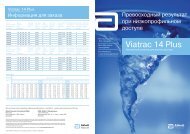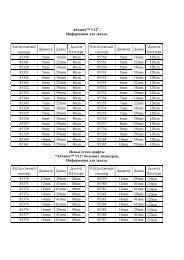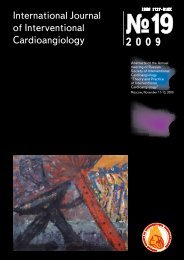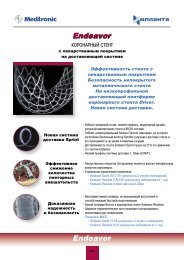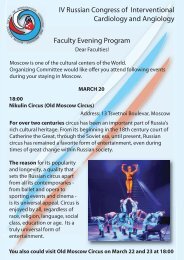Results of Coronary Stenting using the Stents with
Results of Coronary Stenting using the Stents with
Results of Coronary Stenting using the Stents with
Create successful ePaper yourself
Turn your PDF publications into a flip-book with our unique Google optimized e-Paper software.
Интервенционная Cardiovascular ангиология<br />
surgery<br />
limitation <strong>of</strong> dissection, minimization <strong>of</strong><br />
<strong>the</strong> impact on <strong>the</strong> aortic wall, prevention<br />
<strong>of</strong> dilatation and creation <strong>of</strong> conditions<br />
for false lumen thrombosis. Surgical<br />
mortality can be as high as 30% or even<br />
more (5).<br />
Concomitant aortic valve insufficiency,<br />
ring and aortic root dilatation<br />
present in 50-60% <strong>of</strong> cases <strong>of</strong> aortic<br />
dissection usually require surgical aortic<br />
valve replacement, or aortic valve replacement<br />
<strong>with</strong> ascending aorta grafting<br />
<strong>using</strong> Bentall-De Bono technique,<br />
or valve-preserving surgery <strong>using</strong> David<br />
and Yacoub technique.<br />
The fenestrations in <strong>the</strong> aortic arch<br />
occur in 30% <strong>of</strong> dissection cases. In<br />
case <strong>of</strong> fenestrations in <strong>the</strong> aortic arch,<br />
distal anastomosis between <strong>the</strong> graft<br />
and <strong>the</strong> aorta is performed to bypass a<br />
part <strong>of</strong> aortic arch, not involved in dissection.<br />
In any case, if prolonged multiple fenestrations<br />
extend beyond <strong>the</strong> site <strong>of</strong> aortic arch passage<br />
into <strong>the</strong> descending part <strong>of</strong> <strong>the</strong> aorta, it is necessary<br />
to perform subtotal or total arch replacement <strong>with</strong><br />
rebranching <strong>of</strong> several or all aortic branches into <strong>the</strong><br />
graft. This is performed in <strong>the</strong> settings <strong>of</strong> hypo<strong>the</strong>rmic<br />
circulatory arrest and antegrade cerebral perfusion.<br />
If <strong>the</strong> dissection involves also <strong>the</strong> descending<br />
aorta, <strong>the</strong> “elephant trunk” aortic arch reconstruction<br />
is indicated.<br />
Most patients <strong>with</strong> aortic dissection are severely<br />
ill and unlikely to survive traditional open surgical intervention<br />
<strong>with</strong> deep circulatory arrest, aortic arch reconstruction,<br />
etc. Such high-risk patients, as well as<br />
<strong>the</strong> complications occurring during open heart surgery<br />
and pharmacological <strong>the</strong>rapy, have stimulated<br />
<strong>the</strong> search <strong>of</strong> new technologies for <strong>the</strong> treatment <strong>of</strong><br />
aortic dissections — minimally invasive endovascular<br />
interventions.<br />
In general endovascular treatment is being used<br />
for both types <strong>of</strong> aortic dissection — A and B, —<br />
both in acute and in chronic forms. Recent results<br />
<strong>of</strong> meta-analyses have shown technical feasibility <strong>of</strong><br />
endovascular intervention in 98% <strong>of</strong> cases, as well<br />
as encouraging immediate and mid-term results<br />
(1-2 years) (6, 7). The advantages <strong>of</strong> endovascular<br />
interventions and hybrid surgery for aortic dissections<br />
in comparison <strong>with</strong> traditional open surgery are<br />
evident. In particular, endovascular approach allows<br />
to avoid thoracotomy <strong>with</strong> subsequent formation <strong>of</strong><br />
pleural adhesions (8-11). Usually <strong>the</strong> procedure is<br />
performed through <strong>the</strong> femoral approach. Unlike<br />
open operation, primary or repeated endovascular<br />
intervention can be performed under spinal or even<br />
local anes<strong>the</strong>sia. It is evident that in high-risk patients<br />
endovascular interventions have significant advantages<br />
over surgical treatment and <strong>of</strong>fer hope for<br />
recovery for patients <strong>with</strong> contraindications for open<br />
surgery. These advantages comprise <strong>the</strong> decreased<br />
Fig. 1. MHCT <strong>of</strong> patient Z<br />
rate <strong>of</strong> mortality and complications, <strong>the</strong> minimization<br />
<strong>of</strong> time spent in <strong>the</strong> ICU and in hospital, as well as <strong>of</strong><br />
postoperative rehabilitation.<br />
Innovative hybrid surgical approach as a method<br />
<strong>of</strong> effective revascularization, combines <strong>the</strong> effectiveness<br />
<strong>of</strong> traditional open surgery and <strong>of</strong> percutaneous<br />
endovascular intervention <strong>with</strong> balloon valvuloplasty<br />
and endograft implantation. Due to its minimal invasiveness,<br />
<strong>the</strong> hybrid approach allows to minimize<br />
<strong>the</strong> complications and to decrease <strong>the</strong> mortality in<br />
high-risk patients. In case <strong>of</strong> lower limb ischemia this<br />
approach is preferable for legs perfusion <strong>using</strong> extracorporeal<br />
circulation.<br />
Clinical case<br />
The purpose <strong>of</strong> our paper is to present a clinical<br />
case <strong>of</strong> successful two-stage correction <strong>of</strong> type I aortic<br />
dissection <strong>using</strong> hybrid surgical approach.<br />
A 52-years-old woman was admitted to <strong>the</strong> Department<br />
<strong>of</strong> Cardiovascular Surgery on September 10,<br />
2009 <strong>with</strong> complaints <strong>of</strong> restrictive retrosternal pain<br />
associated <strong>with</strong> minimal physical load, palpitations<br />
and pulsation <strong>of</strong> <strong>the</strong> neck vessels. History analysis<br />
revealed that <strong>the</strong> patient had poorly controlled<br />
arterial hypertension for over 20 years (max. BP<br />
190/110 mm Hg). She has considered herself sick<br />
from May 20, 2009, when in <strong>the</strong> night she suddenly<br />
felt an intensive retrosternal pain irradiating into <strong>the</strong><br />
neck and <strong>the</strong> mandible. After 40 minutes <strong>the</strong> pain<br />
has been stopped <strong>with</strong> Nitroglycerin. In-hospital examination<br />
excluded myocardial infarction, EchoCG<br />
revealed severe aortic valve insufficiency. Within<br />
2 weeks after <strong>the</strong> pain attack her body temperature<br />
remained high — 38 0 С. Her condition at admission<br />
was severe, <strong>with</strong> respiration rate at rest — 25/<br />
min. and visible pulsation <strong>of</strong> <strong>the</strong> cervical vessels. A<br />
loud diastolic murmur heard over <strong>the</strong> whole heart,<br />
radiating to <strong>the</strong> carotid arteries, interscapular<br />
space, as well as a systolic murmur <strong>with</strong> maximal<br />
48<br />
(№ 26, 2011)




